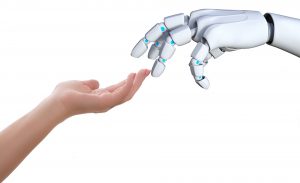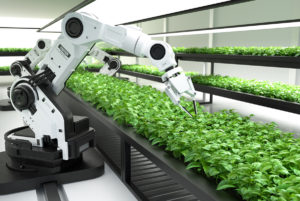Geographic reference: World
Year: 2020 and 2027
Market size: $4.56 billion and $26.68 billion, respectively
As farmworker shortages continue to worsen,1 and the pressure to produce more food for a growing global population increases, more farmers are turning to automation to operate at or near full capacity with fewer workers. Today’s market size shows the total global revenues from agricultural robot sales in 2020 and projected for 2027.
Agricultural robots can help farmers harvest crops, control weeds, and sort and pack produce. Robots can also autonomously mow, prune, seed, and thin plants. Robotic sprayers can keep workers safe as they can be operated autonomously. In addition, because robotic sprayers can be precise, up to 90% less herbicide can be used on crops. Moreover, they can be used in dairy and livestock management, automatic milking robots and sheep shearing robots being two examples. Currently, harvesting robots are the most common robots in use.
North America constitutes the largest share of the global market. This is due to high labor costs, shortage of workers, early adoption of advanced technology in agriculture, greater technological advancements, and the location of many manufacturers in the region. According to the American Farm Bureau Federation, 56% of farms in the United States use agrotechnology, with more than half citing the labor shortage as their reason for doing so. Small and medium-sized farms have suffered the most due to the labor shortage, however, some may find it difficult to invest in agricultural robots due to the high initial cost and need for training. The Asia Pacific region is expected to experience the highest revenue growth through 2027 due to technological advancements and increasing government support. In the Republic of Korea, the Intelligent Robot Development and Supply Promotion Act stated that robots are an essential component of the fourth industrial revolution. Their Basic Plan for Intelligent Robots, published in 2019, calls for systematically selecting industries for governmental and private assistance to integrate robots into business practices. In Japan, robots are a key strategy in Prime Minister Shinzō Abe’s growth policies, increasing the countries research and development budget with the goal of making Japan the world’s leading robot innovation center. Leading global manufacturers of agricultural robots include AGCO, AgJunction, Autonomous Solutions Inc., Autonomous Tractor Corp., Boumatic, Clearpath Robots, Deepfield Robots, DeLaval, GEA Group, Deere & Company, DJI, Harvest Automation John Deere, and Lely among others.
1 Labor shortages plagued the farming sector even before the COVID-19 pandemic, but they were particularly acute during 2020 as countries shut their borders to foreign tourists and workers alike to try to contain the virus.
Sources: “Agriculture Robots Market Size, Share & Trends Analysis Report by Types (Parallel Driverless, Unmanned Aerial Vehicles, Milking Robots, Automated Harvesting Systems, Others), by Application (Harvest Management, Dairy and Livestock Management, Soil Management, Irrigation Management, Field Farming, Pruning Management, Inventory Management, Others), by Farm Outlook (Fruit And Vegetable, Field Crops, Livestock, Others) Based on Region, and Segment Forecasts, 2021 – 2027,” Brand Essence Research Report Description, July 2021 available online here; Lauren Rosenblatt, “Farm Labor Shortage Nothing New, Getting Worse, Farmers Say,” AP News, July 3, 2021 available online here; “(Infographic) The U.S. Farm Labor Shortage,” AgAmerica Lending, February 26, 2020 available online here; “Robotics in Agriculture: Types and Applications,” Automate, December 12, 2017 available online here; Donovan Alexander, “9 Robots That Are Invading the Agriculture Industry,” Interesting Engineering, November 13, 2018 available online here.
Image source: user6702303, “smart-robotic-farmers-concept_17573650,” Freepik, June 15, 2021 available online here
.
Category Archives: Robotics
Smart Robots

Today’s market size shows the revenues from smart robots in 2017 and projected for 2025. Because of their accuracy and efficiency, smart robot adoption is significantly higher in the manufacturing, automotive, healthcare and retail industries. Smart robots for manufacturing dominated the industrial segment of the market in 2017. Smart vacuum cleaners constituted most of the residential segment. Growth in this segment is expected to come from increased demand for other types of smart household cleaning machines (mopping, lawn mowing, pool cleaning) as well as for smart vacuums.
Mobile robots and robots used in a healthcare setting comprise the majority of the professional services segment. Autonomous mobile robots can dynamically re-route themselves due to their advanced sensory and enhanced intelligence systems. As a result no special infrastructure alterations are needed to deploy these devices. This capability gives them an advantage over autonomous guided vehicles that have been used mainly for warehouse distribution and logistics applications. Smart robots used in a healthcare setting are helping doctors perform surgery, disinfecting hospital rooms, providing precise radiation therapy for cancer treatment, and transporting meals, linens, lab samples, waste and other items throughout hospitals. Smart robots such as PARO, a fuzzy, baby harp seal-shaped therapeutic robot, provide comfort, reduce stress, and help improve the socialization skills of people with dementia and similar conditions.
Since the outbreak of COVID-19, disinfection robots have been in high demand. Chinese hospitals have ordered more than 2,000 UVD robots from Blue Ocean Robotics alone. These robots move autonomously around patient and operating rooms using UV-C light to kill 99.99% of viruses and bacteria throughout the room in about 10 minutes. If a person enters the room, the robot automatically shuts off the UV-C light. A device such as this can also be used in offices, schools, shopping malls, airports, and manufacturing facilities.
Notwithstanding the demand caused by COVID-19, growth in the overall smart robot market is expected to be caused by several factors: increasing demand for service robots, increasing adoption of artificial intelligence and Internet of Things applications, falling prices due to innovation and a proliferation of the technology, and the use of robotics in mobile and other smart devices. Government and venture capital funding for smart robots and related technologies is also expected to enhance demand in the near future. Leading manufacturers include ABB Ltd; iRobot Corp.; Kuka AG; Fanuc Corp.; Yaskawa Electric Corp.; Panasonic Industry Europe GmbH; OTC Daihen Inc.; Kawasaki Heavy Industries; Intuitive Surgical Inc.; and Omron Adept Technologies, Inc.
1 See also our Collaborative Robots post.
Geographic reference: World
Year: 2017 and 2025
Market size: $4.06 billion and $17.56 billion, respectively
Sources: “Smart Robot Market by Component (Hardware and Software), Application (Welding & Painting, Assembling & Disassembling, Mobility, Inspection & Security and Others), Industry Vertical (Automotive, Manufacturing, Electrical & Electronic, Food & Beverage, Chemical, Residential, and Others) – Global Opportunity Analysis and Industry Forecast, 2018-2025,” Allied Market Research Report Overview, June 2018 available online here; “Smart Robots Market Size, Share & Trends Analysis Report by Component (Hardware, Software, Service), by Application, by End Use (Industrial, Commercial, Residential), by Vertical, by Region, and Segment Forecasts 2018-2025,” Grand View Research Report Summary, October 2018 available online here; “5 Medical Robots Making a Difference in Healthcare,” Case Western Reserve University, Case School of Engineering, December 28, 2017 available online here; “Executive Summary World Robotics 2019 Service Robots,” International Federation of Robotics, September 18, 2019 available online here; Bennett Brumson, “New Applications for Mobile Robots,” Robotics Industry Insights, April 5, 2012 available online here; Angela Johnston, “Robotic Seals Comfort Dementia Patients But Raise Ethical Concerns,” KALW, August 17, 2015 available online here; “Robots Help to Fight Coronavirus Worldwide,” International Federation of Robotics Press Release, March 31, 2020 available online here; “PARO Therapeutic Robot” available online here.
Image source: Pete Linforth, “connection-hand-human-robot-touch-3308188,” Pixabay, April 10, 2018 available online here.

